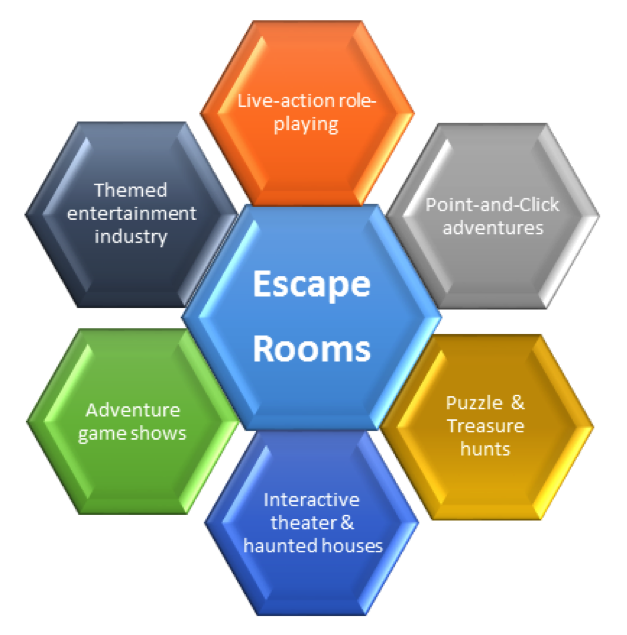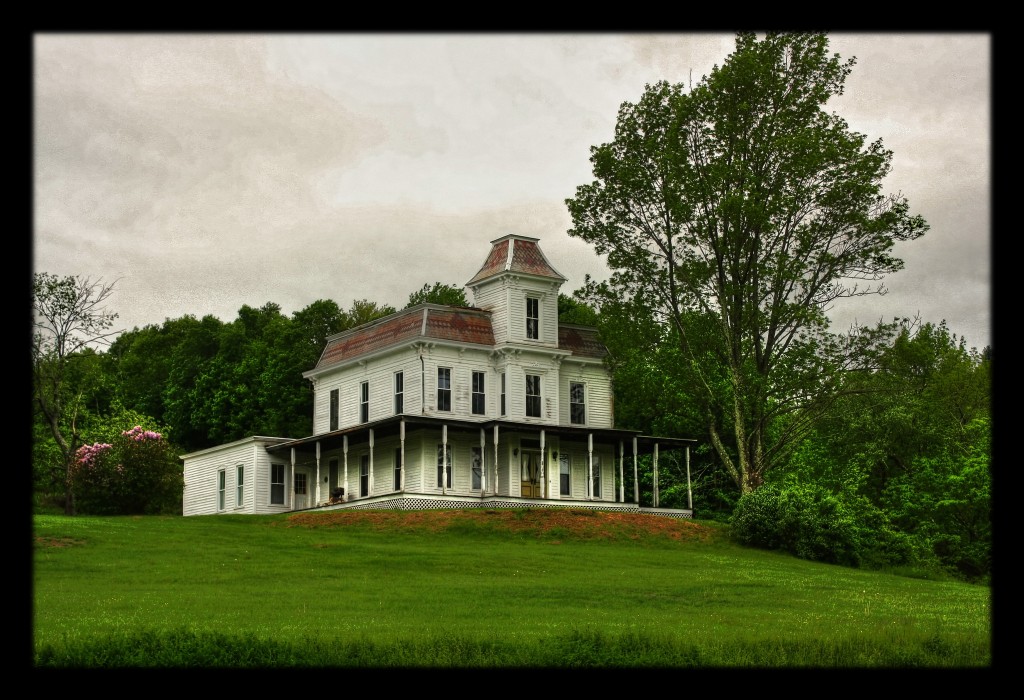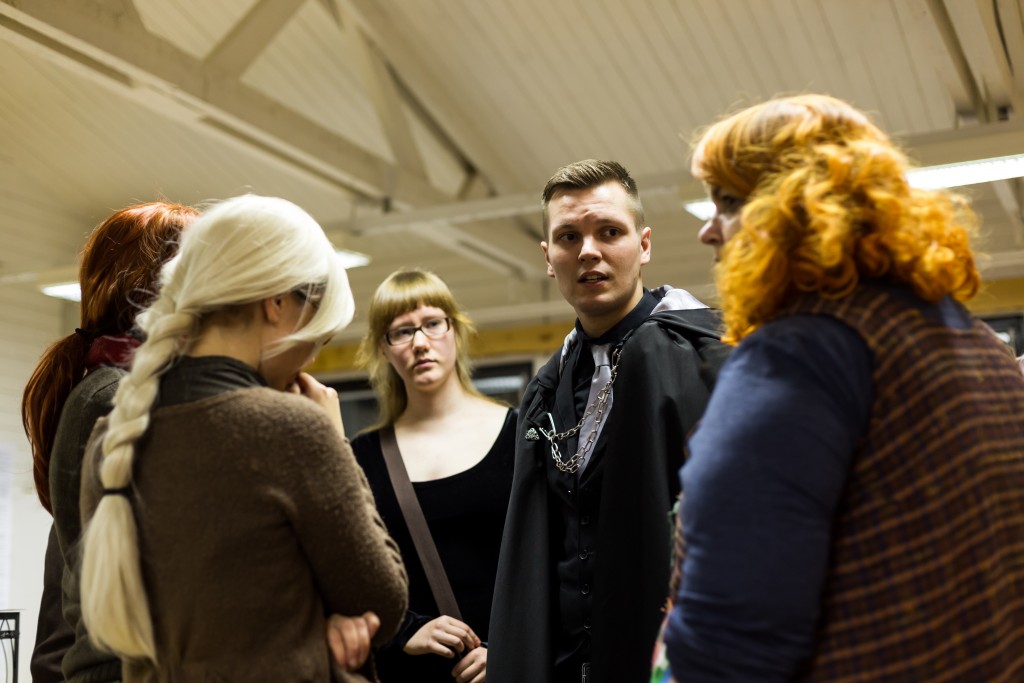Escape rooms are a gaming trend that has spread around the world over the last few years. There are thousands of rooms in Asia and hundreds in Europe and North America, and they are emerging in popular media such as the Big Bang Theory and Late Night with Conan O’Brian. In these analog games, teams of players are challenged to find hidden objects, solve puzzles, and accomplish tasks in about an hour with the goal of escaping a room. As is common with many phenomena in gaming, the question of “what was the single starting point of escape rooms” is one that many in the press desire to answer for their stories.1
The concept of the Escape Room is not the revolution that marketers and reporters claim that winked into existence in Japan in 2007. Instead, it is a convergence of other games and interactive media. As part of a survey I conducted last year, the owners of escape rooms were asked what their inspiration was to start an escape room.2 About 65% of the survey respondents said that their inspiration came from playing in or learning about another escape room; common organizations named were SCRAP from Japan, Parapark in Budapest, Hinthunt in London, and Escape the Room in New York City.
The rest of the respondents were not aware of other escape rooms when they started. Their inspiration came from a variety of sources. Therefore, there is not one single origin for escape rooms; they are a convergence of other games and media. Instead, inspiration grew from a variety of genres such as live-action role-playing, point-and-click adventure games, puzzle hunts, interactive theater, and haunted houses that created the spark in someone’s head to create an escape room. It is the purpose of this paper to explore six precursors to Escape Rooms that emerged from these survey responses and then present escape rooms as an exemplar of the problem in the current divide between digital and non-digital games in game studies.

Precursor 1: Point-and-Click Adventure Games & Escape-the-Room Digital Games
One game genre in which escape room roots can be found is interactive fiction games and their graphical implementation, point-and-click adventure games. Text-based interactive fiction games, most popular in the 1980s, require players to explore locations, find and combine items, and solve puzzles by giving textual commands to a computer. As mice and computer graphics became commonplace, this underlying game concept transitioned into point-and-click adventures; these two-dimensional games required players to explore settings to locate items, combine these items in unusual ways to overcome barriers, solve puzzles, and occasionally engage in insult sword-fighting (as in Monkey Island (1990))to continue the story and explore the world. Myst (1993) was a popular puzzle-based game that took these games into a rich 3-D space; some describe escape rooms as “Live-action Myst.” One direction that the genre moved into was web-based games (and now mobile apps) where players were trapped in a room and had to discover and combine items to solve puzzles and escape. These games became known as Escape-The-Room games, and some of the creators of today’s physical escape rooms were inspired by these digital games.
This point-and-click design concept – locate and combine key items in interesting ways – creates two challenges in escape rooms: inventory management and red herrings. In a digital point-and-click game, key items that are discovered were placed in the player’s inventory. When players were attempting to solve a problem, they could look at their inventory and try putting different items together until a solution was found. Players knew they were on the right track because the two items would fuse into a new renamed item. In addition, red herrings were not frequently used, so players had an expectation that if something could be picked up and put into the inventory, it would be important at some time in the game.
Escape rooms do not offer either of these aids in solving puzzles. There is no indication in the room as to what is important and what is not, so in poorly-designed rooms, many red herring items exist to “dress the set” but end up confusing and frustrating players. With no indication what is important and what is there for theme, players can end up spending valuable time exploring books, posters, and other items that have nothing to do with the game. In addition, there may be no feedback that a player is on the right track in combining two items; it is important that escape room designers ensure players either have information available to confirm that two items need to be combined, or a feedback mechanism so that players know they are on the right track.

Precursor 2: Puzzle Hunts and Treasure Hunts
Another game genre that has been an inspiration to escape room creators was puzzle hunts. In a puzzle hunt, players work in teams to solve a series of puzzles, many of which are paper-based or digitized versions of paper-based puzzles, which then lead to other puzzles, typically with a goal of solving a meta-puzzle that the other puzzles feed into. The puzzle hunt genre has been around for decades, with the MIT Mystery Hunt being one of the best known traditions where the prize for winning is the honor of creating the hunt for the next year. There continues to be a growth in puzzle hunts, some of which center on pubs and the social experience while others provide incredibly challenging and complex puzzles. The puzzles in escape rooms are usually simpler than those found in challenging puzzle hunts, but the team-based experience of solving puzzles is the same. Many escape rooms are structured after puzzle hunts, but with a focus on physical puzzles in a limited space for a single team.
A related activity is the treasure hunt or Schnitzeljagd (in German), where players follow a series of clues in order to discover a treasure. These clues may be puzzles or riddles, and players work together to overcome the challenges and win the game. Modern versions of these treasure hunt games include geocaching and letterboxing, where players either are given GPS coordinates or must solve puzzles to discover coordinates and then, once at the location, search for a hidden box. The same combination of hunting and puzzle solving goes on in an escape room, but in a confined space.
Large-scale escape games, such as the games produced by SCRAP for hundreds of people, use “Escape from the…” in the title, but are actually puzzle hunts with an escape theme more than an escape room model. As such, players expecting the type of activities they normally do in an immersive escape room are disappointed to be handed a pack of pen-and-paper puzzles to work through as quickly as they can, so they can turn in an answer and get more puzzles. Puzzle hunts tend to focus more on players working independently in parallel tracks, so they create a very different play experience than having an escape room designed with large-scale puzzles that groups need to work together to solve. Designers creating “escape room games” for home and classroom use should be aware of the importance of creating group challenges that everyone needs to work together on instead of using the puzzle hunt model to create escape room-themed puzzle hunts.
Precursor 3: Adventure Game Shows and Movies
A third precursor to escape rooms is televised game shows and reality shows that put players in situations where they have to work in teams to solve puzzles and escape a situation. One of the earliest shows from the 1980s in the UK was The Adventure Game, where small teams performed a series of physical puzzle-based tasks to get out of rooms much like today’s escape rooms.3 Knightmare, another series from the UK from the mid-80s, put children in teams where one player wore a helmet and wandered around in front of a blue screen and interacted with props and actors while teammates watched a rendered version of the activities and provided advice.4 Fort Boyard and The Crystal Maze and were both team-based game shows started in the 1990s that combined physical prowess and mental agility,5 but lost the narrative that the earlier shows relied upon.
http://www.youtube.com/watch?v=0jxQshe_b7s
These early game shows were a precursor to the reality shows that followed, starting with Survivor (2000) and The Amazing Race (2001). Many of these reality shows had large-scale games and puzzles that players had to work together to solve, thus providing inspiration for escape room creators to develop the sense of spectacle that these shows provide. The popularity of these shows raised the cultural awareness of the activity of working together to solve a series of puzzles and accomplish tasks in a physical world.
Movies that portray adventures also have inspired some creators of escape rooms. Matt Duplessie was inspired by the Indiana Jones (1981-2008) franchise to start his 5 Wits Productions, as he wanted to create the opportunity for the player to live the adventure.6 Other escape room proprietors pointed to horror adventures like Saw (2004) and Cube (1998) as inspiration for escape rooms, as players are trapped in a space and have to rely upon their wits to escape. This concept has come full circle with Race to Escape, a 2015 six-episode series where three-player teams competed in identical rooms to see who could get out first.
Precursor 4: Interactive Theater and Haunted Houses
The growth of interactive theater runs parallel to the growth of escape rooms. In both cases, participants are invited to engage with their environments in an interactive space that allows them to take an active role in their entertainment. Some of the creators of Escape rooms mentioned Sleep No More (2011) and Then She Fell (2012), two interactive theater experiences in New York City, as inspirations for their escape rooms. Haunted houses are closely related to these interactive theater experiences, as small groups of participants move from space to space engaging with actors and exploring a story. Many flock to horror-themed escape rooms that combine elements of haunted houses with puzzle hunts where players are trapped in the dark, taunted by chained-up zombies or shackled to walls. These lines will continue to blur with interactive haunted houses, such as Trapped at Knott’s Berry Farm, where players take on tasks and solve simple puzzles to find their way out of a haunted house.
The haunt industry is moving into the escape room space quickly, as escape rooms provide another way for those who produce haunts to have themed experiences that are of interest to customers during the off season. The large haunt conferences in the United States are adding escape room tracks, and it is expected that there will be a growth of vendors who supply the haunt industry to add versions of their products created explicitly for escape rooms. Many of the electronics and set pieces used in haunted houses could be easily adapted for escape rooms, and the horror genre is one of the more popular settings for escape rooms. This will also create more haunted houses that integrate puzzle-based experiences to heighten engagement and tension.
What is interesting about this combination of these two industries is that it will come out of North America where the haunt industry is much larger than around the world. While the larping approach, detailed below, may be stronger in Europe where larp is more widely accepted, and in Asia with the more common acceptance of cosplay, the haunt-based escape room approach may overtake the much smaller puzzle-focused escape room industry in the North America. It will be interesting to what influence the North American haunt market has on escape room design worldwide.

Precursor 5: Live-Action Role-Playing
Another game genre that feeds into escape rooms is role-playing games and, more specifically, live-action role-playing games. As the popularity of Dungeons and Dragons grew, gamers wanted to experience their tabletop fantasies in more immersive settings. In the 1980s, a number of national organizations, such as the New England Role Playing Organization (NERO) and the International Fantasy Gaming Society (IFGS), provided rulesets and scenarios for players to dress up in costume, arm themselves with foam-covered weapons, and engage in scenarios that combined role-playing, puzzle solving, and combat.7 Some of these escape room precursors had players searching for clues and solving puzzles to escape from locked rooms made of tarp-covered frames out in the woods. True Dungeon took these concepts from live-action role-playing and created an event for Gen Con in 2003 where players worked through rooms solving puzzles under a time limit. Each player had a character, and fought monsters through a shuffleboard system, but there was no live-action combat. The focus was on mental skills and using class abilities instead of role-playing, and continues to be one of the most popular events at Gen Con.8
When I presented this idea of escape rooms as being a part of live-action role-playing to online communities of owners and designers when discussing the results of this survey, many from North America were vocal in disagreement in connecting Escape Rooms to role-playing games. Owners responded that they believed it would hurt their business if potential visitors of these rooms believed there would be role-playing involved by the players. Part of this is cultural; larp is not seen in a positive light in North America, but it is more openly accepted in European countries, and is closely related to cosplay, which is accepted in Asian cultures. The implication of this appears in the design of these rooms, where many designers tack on a superficial narrative layer onto a series of themed puzzles instead of using the puzzles to convey the narrative. Using larp design concepts would encourage room designers to create player roles that matter in the story instead of relying upon stories where the players happened upon a situation. If players are not given the chance to immerse themselves into the narrative, then these rooms will continue to feel like a series of themed puzzles instead of offering rich narrative explorations. Offering players meaningful choices that emerge from exploring narratives is a future step in creating more engaging escape rooms.

Precursor 6: Themed Entertainment Industry
Finally, escape rooms are at the intersection of games and themed entertainment, which creates a challenge for those planning and running escape room games as a business. Escape rooms are not the first commercial enterprises built around live-action puzzles. A few precursor businesses for escape room-like activities were Entros, a restaurant founded in Seattle in 1993 but no longer open, where diners participated in mystery games that took them throughout the restaurant, solving physical puzzles while others continued to dine.9 5 Wits is a US franchise which first opened in 2003 and has teams working together to solve physical puzzles in an immersive environment within a certain amount of time to escape to the next room. MagiQuest, a feature of the Great Wolf Lodge franchise where players go on a scavenger hunt for items powered by a book of riddles and an electronic wand, debuted in 2006.10
The themed entertainment industry also could be a place where the escape room industry could find a home, which would provide a way for escape room designers to work with amusement and theme parks to create more opportunities for group puzzle-based experiences outside of standalone experiences. However, there would be some challenge to this partnership, considering that activities in amusement parks need to be able to handle hundreds of participants an hour and that activities for smaller groups of guests usually require a significant upcharge and/or booking well in advance. Several large theme parks have already integrated analog/digital scavenger hunt activities into its parks, where guests travel from station to station solving simple puzzles built into a narrative, which results in the physical environment responding to the player. While simple, these puzzle-based challenges represent interest in the industry of creating interactive challenges that engage the minds of the guests and involve them in active roles instead of treating them as passive observers of an attraction.
Conclusions
There is no single origin point for Escape Rooms; they are a convergence of many other interactive activities and media. The search for a single point of origin of a new phenomenon is dangerous as it can blind people to the influence that different elements had in converging to create the phenomenon. This creates the copycat situation that we see in many current game design streams where designers look for one thing to copy and modify instead of looking at a variety of games, play, static, and interactive analog and digital experiences for inspiration.
Understanding the variety of precursors to Escape Rooms is valuable for Escape Room game designers, as it greatly increases the toolkit that these designers have in creating more engaging rooms. Too many escape rooms designers are cloning what they see in other rooms and relying upon tropes such as padlocks and black lights instead of trying new things, and looking to these precursors for inspiration can help. In addition, there are opportunities for those with experience in escape room design to bring these concepts to improve haunted houses, live-action role-playing, and the themed entertainment industry to keep live-action puzzle-based entertainment evolving. Examining escape rooms as a hybrid of design concepts from analog and digital games as well as other forms of media highlights a problem in the way games are typically considered in both scholarly and recreational circles. Game shops, gaming web sites, and game studies conferences tend to have an explicit focus on either digital or analog games. This divide makes it challenging to recognize the influence that each has on the other, even in this growth period of analog/digital games, such as digital game implementations of tabletop games and tabletop games with digital components. Do escape rooms, with their point-and-click video game design concepts married with the live-action analog space implementations belong in either community, and where in scholarship do they fall?
When scholars are deciding in which area to publish, they can be heavily influenced by the venues that are available. If most venues for publication and communities have Digital, Video, or something similar in their titles, these budding scholars will be less likely to explore analog or live-action games. Thus, while there has been considerable growth in the non-digital game industries and the related design space in the last few decades, few scholars are exploring these areas. Behind the scenes, many publications and conferences will consider a piece focusing on analog games, but to someone entering the field, the appearance is that digital game studies is the only feasible route. As new game-based activities emerge from the hybrid space of analog and digital games, the boards of large scholarly and professional organizations are encouraged to recognize the importance of dropping the Digital or Video names from their titles to encourage a broader exploration of all types of games and to stop discouraging young scholars from selecting a focus on a form of game that is not explicitly supported by the academy.

—
Featured image “Krakow Door” by John Finn @Flickr.
—
Scott Nicholson, PhD (@snicholson) is Professor and Director of the Game Design and Development program at Wilfrid Laurier University in Brantford, Ontario, Canada. He also directs the Brantford Games Network and the BGNlab, which brings together students, gamers, community members, game companies, and organizations that support learning to create transformative games. His primary research areas are escape rooms and other live-action games that bring people together for educational or team-building purposes and other forms of meaningful gamification. He was also the creator and host of Board Games with Scott, the first web-based video series about board games, and was the designer of the board games Tulipmania 1637 and Going, Going, Gone.


The main worry that I have in decentralizing the origin story of escape games is that it runs the risk of avoiding giving credit for the form to key developers in Asia, or at least outside of North America and Western Europe. Already, most folks I encounter in the U.S. don’t know that the games have strong ties to Asia and are even more prevalent and commonplace there. For sure, in the English-speaking world, people often claim a variety of inspirations, and that’s great, but it also intentionally or unintentionally obscures parts of the form’s history and makes it seem like a purely North American invention. I’ve seen multiple websites where venue proprietors essentially claim to have invented escape games themselves or where they come up with fancy terms to hide the fact that they’re part of what’s now a widespread tradition in game design. Clearly there is power in origin stories and trying to manage how they are told, and I have to say that I haven’t been impressed so far with the way many proprietors describe the medium, its origins, and its development to customers, the media, and so on. Maybe they themselves are unfamiliar with the history and development of escape games outside of the United States (or even outside of the few examples they’ve personally seen), but it feels to me — though I could be wrong — that this history is being obscured or ignored as much as it’s been unintentionally lost or remains shrouded in obscurity or multiple related developments.